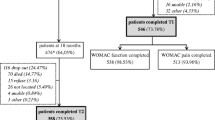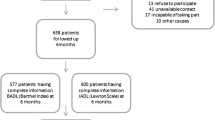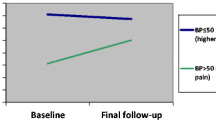Abstract
The aim of this prospective study was to document the functional outcome and quality of life (QoL) over 1 year following hip fracture in elderly women. A total of 159 unselected elderly women with a first hip fracture were matched for age and residence with an equal number of control women. Functional status was measured by completing a Rapid Disability Rating Scale version 2 (RDRS-2) questionnaire [score ranging from 0 (best) to 54 (worse)], before hospital discharge and 12 months later. To examine longitudinal change in health-related QoL, fracture subjects and controls completed the Short Form 36 (SF-36) questionnaire. For the 134 women still alive at 1 year, the mean RDRS-2 score before hospital discharge was 16.2 (95% CI: 15.0–18.0) and 3.5 (2.6–4.3) in patients and controls, respectively (P<0.001). During the year following hospital discharge, the mean RDRS-2 score improved to 13.0 (11.1–14.1) in hip-fracture women and worsened to 4.3 (3.3–5.0) in the control group (differences with initial scores: P<0.001 in both groups). After adjustment for potential confounders (including age and comorbidity), the estimated functional decline attributable to a hip fracture was 24% in the first year. Poor functional status upon discharge was the strongest predictor of a poor functional status at 1 year. Overall, similar trends were observed when using SF-36 scores as compared with RDRS-2 scores. However, only 51% of the study population was able to complete the SF-36 questionnaire at discharge and after 1 year, and these subjects were considerably younger (P<0.001), had less cognitive impairment (P<0.001), and had better functional status (P<0.001) than those who were unable to complete the SF-36. For those women able to complete the SF-36 questionnaires, the mean SF-36 score before hospital discharge was 56.4 (95% CI: 51.9–60.9) and 71.1 (67.5–74.8) in patients and controls, respectively (P<0.001). During the year following hospital discharge, the mean SF-36 score improved significantly to 61.1 (56.5–65.7) in hip-fracture patients (P=0.03), but remained unchanged in the control group (P=0.23). Overall, the results of this study indicate that women who sustain a hip fracture continue to suffer from substantial functional impairment and loss in QoL at 1 year, despite a significant recovery during this 12-month period. Function upon hospital discharge is the strongest predictor of functional status 1 year later. Assessing QoL in hip fracture women through self-administered questionnaires is subject to considerable bias due to non-response.

Similar content being viewed by others
References
Cooper C (1997) The crippling consequences of fractures and their impact on quality of life. Am J Med 103(2A):12S–19S
Cree M, Soskolne CL, Belseck E, Hornig J, McElhaney JE, Brant R et al. (2000) Mortality and institutionalization following hip fracture. J Am Geriatr Soc 48:283–298
Haentjens P, Autier P, Barette M, Boonen S (2001) The economic cost of hip fractures among elderly women. A one-year, prospective, observational cohort study with matched-pair analysis. J Bone Joint Surg [Am] 83-A:496–500
Cooney LM (1997) Do we understand the true cost of hip fractures? J Am Geriatr Soc 45:382–383
Autier P, Haentjens P, Bentin J, Baillon JM, Grivegnée AR, Closon MC, Boonen S (2000) Costs induced by hip fractures: a prospective controlled study in Belgium. Osteoporos Int 11:373–380
Linn MW, Linn BS (1982) The rapid disability rating scale-2. J Am Geriatr Soc 30:378–382
Ware JE, Sherbourne CD (1992) The MOS 36-item short form health survey (SF-36): conceptual framework and item selection. Med Care 30:473–483
Magaziner J, Simonsick EM, Kashner TM, Hebel JR, Kenzora JE (1990) Predictors of functional recovery 1 year following hospital discharge for hip fracture: a prospective study. J Gerontol Med Sci 45:M101–107
Fox KM, Hawkes WG,Hebel JR, Felsenthal G, Clark M, Zimmerman SI et al. (1998) Mobility after hip fracture predicts health outcomes. J Am Geriatr Soc 46:169–173
Fox KM, Magaziner J, Hebel JR, Kenzora JE, Kashner TM (1999) Intertrochanteric versus femoral neck hip fractures: differential characteristics, treatment, and sequelae. J Gerontol Med Sci 54A:M635–M640
Greendale GA, DeAmicis TA, Bucur A, Bretsky P, Rowe JW, Reuben DB et al. (2000) A prospective study of the effect of fracture on measured physical performance: results from the MacArthur Study—MAC. J Am Geriatr Soc 48:546–549
Koval KJ, Skovron ML, Aharonoff GB, Zuckerman JD (1998) Predictors of functional recovery after hip fracture in the elderly. Clin Orthop 348:22–28
Mossey JM, Mutran E, Knott K, Craik R (1989) Determinants of recovery 12 months after hip fracture: the importance of psychosocial factors. Am J Public Health 79:279–286
Svensson O, Strömberg L, Öhlen G, Lindgren U (1996) Prediction of the outcome after hip fracture in elderly patients. J Bone Joint Surg [Br] 78-B:115–118
van Balen R, Steyerberg EW, Polder JJ, Ribbers TL, Habbema JD, Cools HJ (2001) Hip fracture in elderly patients: outcomes for function, quality of life, and type of residence. Clin Orthop 390:232–243
Wolinsky FD, Fitzgerald JF, Stump TE (1997) The effect of hip fracture on mortality, hospitalization, and functional status: a prospective study. Am J Public Health 87:398–403
Young Y, Brant L, German P, Kenzora J, Magaziner J (1997) A longitudinal examination of functional recovery among older people with subcapital hip fractures. J Am Geriatr Soc 45:288–294
Randell AG, Nguyen TV, Bhalerao N, Silverman SL, Sambrook PN, Eisman JA (2000) Deterioration in quality of life following hip fracture: a prospective study. Osteoporos Int 11:460–466
Hall SE, Criddle RA, Comito TL, Prince RL (1999) A case-control study of quality of life and functional impairment in women with long-standing vertebral osteoporotic fracture. Osteoporos Int 9:508–515
Cooper C, Barker DJP, Wickham C (1988) Physical activity, muscle strength, and calcium intake in fracture of the proximal femur in Britain. BMJ 297:1443–1446
Meyer HE, Henriksen C, Falch JA, Pedersen JI, Tverdal A (1995) Risk factors for hip fracture in a high incidence area: a case-control study from Oslo, Norway. Osteoporos Int 5:239–246
Cummings SR, Melton III LJ (2002) Epidemiology and outcomes of osteoporostic fractures. Lancet 359:1761–1767
Lingard EA, Wright EA, Sledge CB, and the Kinemax Outcomes Group (2001) Pitfalls of using patient recall to derive preoperative status in outcome studies of total knee arthroplasty. J Bone Joint Surg [Am] 83-A:1149–1156
Acknowledgements
We are indebted to the participating women and their families. This work was partly supported by a medical research grant from Merck Sharp and Dohme BV, Belgium. This study was supported by grant G.0171.03 from the Fund for Scientific Research, Flanders, Belgium (F.W.O.-Vlaanderen) to S. Boonen. Dr. S. Boonen and Dr. D. Vanderschueren are senior clinical investigators of the Fund for Scientific Research, Flanders, Belgium (FWO Vlaanderen). Dr. S. Boonen is holder of the Leuven University Chair in Metabolic Bone Diseases, founded and supported by Merck, Sharp & Dohme.
Author information
Authors and Affiliations
Corresponding author
Additional information
The authors represent the Belgian Hip Fracture Study Group, the full membership of which comprises the following investigators: P. Autier, Division of Epidemiology and Biostatistics, European Institute of Oncology, Milan, Italy, and Center for Research in Epidemiology and Health Information Systems Luxemburg, Grand Duchy of Luxemburg; J.M. Baillon, Department of Orthopedics, Ixelles-Etterbeek Hospital, Brussels, Belgium; M. Barette, Unit of Epidemiology and Prevention of Cancer, Jules Bordet Institute, Brussels, Belgium; J. Bentin, Service of Rheumatology, Louis Cathy Hospital, Baudourt, Belgium; S. Boonen, Leuven University Center for Metabolic Bone Diseases and Division of Geriatric Medicine, Katholieke Universiteit Leuven, Leuven, Belgium; R. Bouillon, Leuven University Center for Metabolic Bone Diseases and Division of Endocrinology, Katholieke Universiteit Leuven, Leuven, Belgium; P. Broos, Leuven University Center for Metabolic Bone Diseases and Division of Traumatology and Emergency Surgery, Katholieke Universiteit Leuven, Leuven, Belgium; M.C. Closon, Interdisciplinary Center in Health Economics, Université Catholique de Louvain, Brussels, Belgium; A.R. Grivegnée, Unit of Epidemiology and Prevention of Cancer, Jules Bordet Institute, Brussels, Belgium; P. Haentjens, Department of Orthopaedics and Traumatology, Vrije Universiteit Brussel, Brussels, Belgium; P. Opdecam, Department of Orthopaedics and Traumatology, Vrije Universiteit Brussel, Brussels, Belgium; D. Vanderschueren, Leuven University Center for Metabolic Bone Diseases and Division of Endocrinology, Katholieke Universiteit Leuven, Leuven, Belgium.
Rights and permissions
About this article
Cite this article
Boonen, S., Autier, P., Barette, M. et al. Functional outcome and quality of life following hip fracture in elderly women: a prospective controlled study. Osteoporos Int 15, 87–94 (2004). https://doi.org/10.1007/s00198-003-1515-z
Received:
Accepted:
Published:
Issue Date:
DOI: https://doi.org/10.1007/s00198-003-1515-z




